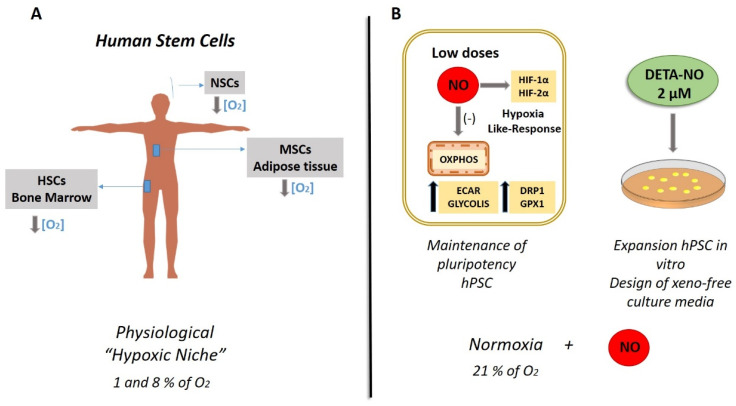Figure 2.
Physiological human stem cell niches versus nitric oxide-based in vitro cultures. (A) Hypoxic niches of stem cells (SCs). The figure shows the O2 tensions characteristic of the biological niches of MSCs, NSCs, and HSCs. Various studies have determined by direct measurement or applying various mathematical models the O2 tension in bone marrow, adipose tissue, and the ventricular zone of the brain where the respective SCs reside. The results showed levels between 1 and 8% of O2, revealing an O2 tension lower than the atmospheric one (21% of O2). Direct measurements in the brain have not been carried out, but tensions of 0.55% O2 have been recorded in other attached regions in rodents, and conceptual translation to humans has been carried out. MSCs (mesenchymal SCs); NSCs (neural SCs); HSCs (hematopoietic SCs) [76]. (B) Low DETA-NO in normoxia (21% O2) encourages a response similar to hypoxia in PSCs. Therefore, exposure to 2 µM DETA-NO led to the accumulation of HIF-1α and HF-2α proteins, increased expression of pluripotency genes NANOG and OCT-4, and a shift towards the expression of genes favoring glycolitic metabolism. Mitochondrial functions and dynamics were also affected, with a decrease in OXPHOS, an increase in ECAR and DRP1 expression. These actions are not dependent on changes in mROS levels while GPX1 mRNA expression increase, which is compatible with the maintenance of pluripotency as it is described in the review. All in all, these outcomes indicate that NO induces a hypoxia-like response, regulating mitochondrial functionality and metabolic parameters in human PSCs, thus maintaining pluripotency [14]. In this context, the use of NO is proposed to supplement culture media for human PSCs (hPSCs) expansion. NO (nitric oxide); OCR (O2 consumption rate); ECAR (extracellular acidification rate), OXPHOS (oxidative phosphorylation).

